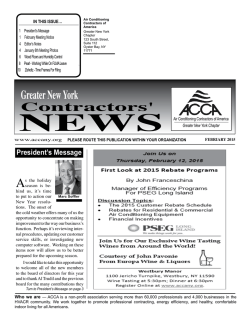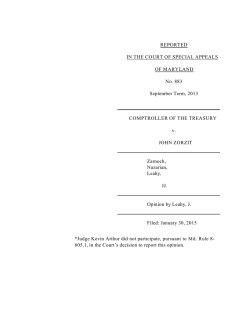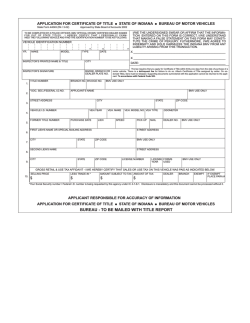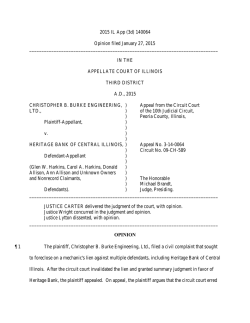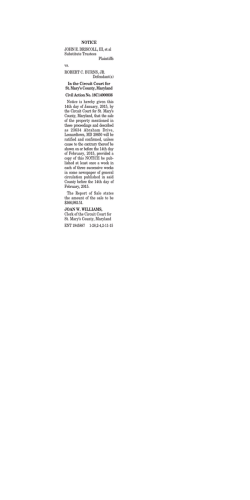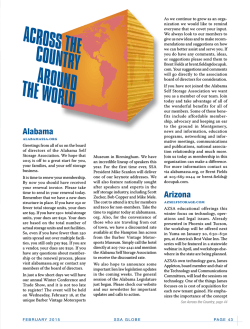
REPORTED IN THE COURT OF SPECIAL APPEALS
REPORTED IN THE COURT OF SPECIAL APPEALS OF MARYLAND No. 0009 September Term, 2014 STATE OF MARYLAND, COMPTROLLER OF MARYLAND v. KENNETH R. SHIPE Woodward, Hotten, Thieme, Raymond G., Jr. (Retired, Specially Assigned), JJ. Opinion by Hotten, J. Filed: February 3, 2015 Appellant, the Comptroller of Maryland (“the State”), appeals from a judgment entered by the Circuit Court for Montgomery County, granting appellee’s, Kenneth R. Shipe’s, motion to release a tax judgment lien held by the State for unpaid income taxes regarding the 1997 and 1998 tax years. The State noted an appeal and presents a single question for our review: Did the circuit court err in holding that a properly recorded tax lien in favor of the [S]tate with respect to an undisputed, unsatisfied tax obligation is subject to the statute of limitations applicable to “specialties” in § 5-102 of the Courts and Judicial Proceedings Article where that statute expressly provides that it “does not apply to a specialty taken for the use of the State” and where the State has not waived its sovereign immunity? For the following reasons, we shall reverse the judgment of the circuit court. FACTUAL AND PROCEDURAL HISTORY On April 26, 2001, the State issued a “Notice of Lien of Judgment for Unpaid Tax” to appellee because of his failure to pay $2,111.70 in income taxes for the period of January 1, 1997 through December 31, 1998.1 On May 8, 2001, the notice of lien of judgment was recorded, indexed, and entered in the docket by the Circuit Court for Montgomery County. On June 19, 2013, appellee filed a “Motion to Release Judgment/Tax Lien” with the Circuit Court for Montgomery County. 2 Citing § 5-102(a)(3) of the Courts and Judicial Proceedings Article, appellee argued that the judgment/tax lien was subject to renewal and therefore, “became unenforceable by reason of lapse of time on May 8, 2013.” In response, 1 Additionally appellee owed a $637.93 penalty and $793.54 in accumulated interest, which totaled $3,543.17. 2 The Comptroller had not renewed the tax lien prior to this date. the State cited § 5-102(c) of the Courts and Judicial Proceedings Article and contended that “the twelve-year limitation section ‘[did] not apply to a specialty taken for the use of the State.’” On August 27, 2013, a hearing was held to address appellee’s motion. Following oral argument, the circuit court requested additional information, took the motion under advisement and requested that the parties submit memoranda within fourteen days. The circuit court issued an order on December 2, 2013, “find[ing] that a plain reading of the statutes and cases cited clearly demonstrates the intent of the General Assembly to impose time limits on the Comptroller to enforce a tax lien once filed,” thereby, releasing the State’s tax lien. On December 13, 2013, the State filed a motion for reconsideration, which the circuit court denied on February 3, 2014. Thereafter, the State noted a timely appeal. Additional facts shall be provided, infra, to the extent they prove relevant in addressing the issues presented. STANDARD OF REVIEW The issue before this Court is one of statutory construction. Upon review, our primary goal in statutory interpretation is “to ascertain and effectuate the intent of the legislature.” Rossville Vending Mach. Corp. v. Comptroller of the Treasury, 114 Md. App. 346, 351 (1997) (citation omitted). We start our analysis by “begin[ning] with the plain language of the statute, and ordinary, popular understanding of the English language dictates interpretation of its terminology.” Bowen v. City of Annapolis, 402 Md. 587, 613 (2007) (quoting Kushell v. Dep’t of Natural Res., 385 Md. 563, 576 (2005)). “This plain -2- meaning should be construed to carry out and effectuate, or aid in, the general purposes and policies of the statute being interpreted. When reading the statute, we apply ‘a common sense perspective’ of how the statutory language is generally understood.” Maryland Econ. Dev. Corp. v. Montgomery County, 431 Md. 189, 199 (2013) (internal quotation marks and citations omitted). Additionally, the Court of Appeals discussed the basic concepts governing statutory construction, noting: If the language of the statute is clear and unambiguous, we need not look beyond the statute’s provisions and our analysis ends. If however, the language is subject to more than one interpretation, it is ambiguous, and we resolve that ambiguity by looking to the statute’s legislative history, case law, and statutory purpose. Barbre v. Pope, 402 Md. 157, 173 (2007) (citations omitted). Further, “laws enacted for the collection of general taxes must be interpreted with very great liberality; consequently, construction should not be undertaken with an eye to defeating the legislation, but with both eyes focused on giving it force, if reasonably possible.” Surratts Associates v. Prince George’s Cty, 286 Md. 555, 566 (1979). DISCUSSION We have before us an issue of first impression regarding whether the statute of limitations applies to a tax/judgment lien held by the State of Maryland. Maryland Code (1988 Repl. Vol. 2010), § 13-805 of the Tax-General Article [hereinafter “Tax-Gen.”] states: Unpaid Tax. (a) In general.— Unpaid tax, interest, and penalties constitute a lien, in favor of the State, extending to all property and rights to property belonging to: -3- (1) the person required to pay the tax. . . . Pursuant to Maryland Code (1988 Repl. Vol. 2010), § 13-808 of the Tax-General Article: From the date on which a tax lien is filed under § 13-8073 of this subtitle, the lien has the full force and effect of a judgment lien. The State avers that Maryland Code (1974 Repl. Vol. 2013), § 5-102(a) of the Courts & Judicial Proceedings Article [hereinafter “Cts. & Jud. Proc.”] is the sole statutory support for the application of a statute of limitations to a judgment lien. Cts. & Jud. Proc. § 5102(a) states: (a)Twelve-year limitation.— An action on one of the following specialties shall be filed within 12 years after the cause of action accrues, or within 12 years from the date of the death of the last to die of the principal debtor or creditor, whichever is sooner: (1) Promissory note or other instrument under seal; (2) Bond except a public officer’s bond; (3) Judgment; 3 §13-807. Filing, indexing, and recording. (a) Filing notice of tax lien.— A tax collector may file a notice of tax lien with the clerk of the circuit court for the county where the property that is subject to the lien is located. (b) Recording and indexing tax lien.— (1) On receipt of a notice of tax lien, the clerk of a circuit court promptly shall: (i) record and index the lien; and (ii) enter the lien in the judgment docket of the court. (2) The docket entry shall include: (i) the name of the person whose property is subject to the tax lien; and (ii) the amount and date of the tax lien. -4- (4) Recognizance; (5) Contract under seal; or (6) Any other specialty. In contrast, appellee contends that the life of a tax lien is defined by Maryland Code (1988 Repl. Vol. 2010), § 13-1103 of the Tax-General Article, which states: (a) 7 year limit.— Except as otherwise provided in this section, a tax imposed under this article may not be collected after 7 years from the date the tax is due. (b) 2 year extension for appointment of receiver or trustee.— If a tax collector fails to collect a tax and a receiver or trustee is appointed within the period specified in subsection (a) of this section to complete the tax collection, the period for collecting the tax extends for 2 years from the date that the trustee or receiver is appointed. (c) Collection action after timely assessment.— If the assessment of any tax has been made within the period of limitations applicable to the assessment, a tax may not be collected after 7 years from the date of the assessment. Any judgment entered may be enforced or renewed as any other judgment. We agree with the State that Tax-Gen. § 13-1103 would not apply to the circumstances of this case. We provided an analysis to support this conclusion in Rossville Vending Mach. Corp. v. Comptroller of the Treasury, 114 Md. App. 346 (1997). In Rossville, as a case of first impression, we determined the “period of limitations applicable to enforcement of a recorded tax lien.” Id. at 347. We discussed how Maryland Code (1988 Repl. Vol. 2010), § 13-806 of the Tax-General Article, which governs the duration of liens, does not reference Tax-Gen. § 13-1103. Id. at 352. Tax-Gen. § 13-806, states: (a) In general.— Unless another date is specified by law and except for a lien under subsection (b) of this section, a lien arises on the date of notice that the tax is due and continues to the date on which the lien is: -5- (1) satisfied; or (2) released by the tax collector because the lien is: (i) unenforceable by reason of lapse of time; or (ii) uncollectible. (b) Inheritance tax lien.— (1) Except as otherwise provided in this subsection, a lien for unpaid inheritance tax: (i) arises on the date of distribution; and (ii) continues for 4 years. (2) If the property is subject to a special valuation under § 7-211 of this article, a lien: (i) arises on the date on which the interest in the property vests in possession; and (ii) continues for 4 years. (3) If the unpaid inheritance tax is attributable to the disqualification of property that was qualified for special valuation or exemption under § 7-211 of this article, the lien: (i) arises on the date on which the decedent died; and (ii) continues for 20 years. In rejecting the taxpayer’s contentions that “§ 13-808 only gives tax liens the same priority as judgment liens and does not vitiate the statute of limitations set forth in §13-1103[,]” we stated: [I]t provides a four year statute of limitations for inheritance tax liens and, with respect to all other tax liens, provides that the lien shall continue until it is satisfied or released by the tax collector because it is unenforceable by reason of lapse of time or uncollectible. -6- Our reading of §§ 13-806, 13-808, and 13-1103 persuades us that the limitations provision of § 13-1103 applies only to actions to collect tax instituted under § 13-816 and not to enforcement of liens recorded in accordance with § 13-807. As indicated by the Comptroller, § 13-1103(c) expressly exempts enforcement of judgments from the seven year statute of limitations. Specifically, it provides that “[a]ny judgment entered may be enforced or renewed as any other judgment.” Further, we read § 13-808 to give recorded State tax liens the same effect as judgment liens for all purposes, including enforcement purposes. Section 13-808 provides that properly recorded State tax liens are to be enforced in the same manner as any judgment lien in favor of the State. Id. at 350, 352-53. Thereafter, we provided the legislative history of Tax-Gen. §§ 13-808 and 13-1103 to support our conclusion. Id. at 353-56. Tax-Gen. § 13-808 was originally enacted in 1947 as §278(b) of Article 81 and, stated: The tax, and all increases, interests and penalties thereon shall be a lien upon the property of any person liable to pay the same to the State for a period of four (4) years from and after the time when such tax becomes due and payable as provided herein. Id. at 354 (quoting Art. 81, §278, Md. Code Ann. (1947)). In 1949, the General Assembly amended §278, removed the four year statute of limitations and added additional language including, “[t]he lien provided for in this section shall have the full force and effect of a lien of judgment,” and “[u]nless another date is specified by law, the lien arising at the date of non-payment as in this section specified and provided for, shall continue with the same force and effect as a judgment lien.”4 Id. Section 278 was later recodified as § 342 of 4 Art. 81, § 278(b), Md. Code Ann. (1949) states: The tax, and all increases, interests and penalties thereon shall be a lien upon the property of any person liable to pay the same to the State from and after the time when notice has been given that such tax has (. . . continued) -7- Article 81, with no substantive changes, and subsequently, was recodifed again as TaxGen. § 13-808. Id. at 354. The predecessor to Tax-Gen. § 13-1103 is former Art. 81, § 212, Md. Code Ann. (1980 Repl. Vol., 1986 Supp.)) Id. at 355-56. The taxpayer contended that this section “treated actions at law or suits in equity in the same manner as enforcement of liens.” Id. at 355. The pertinent section, the taxpayer was referring to, stated: All State, county or city taxes of every kind for which no other period of limitation is prescribed by this article shall be collected within four years after they shall become due, . . . provided . . . (b) that any action at law or suit in equity for collection of such taxes or for sale of property to pay the same or for the enforcement of any lien therefor, may, if instituted within the period hereinabove prescribed[,] be prosecuted as if this section had never been passed, and any judgment or decree therein may be enforced or renewed as other judgments or decrees. . . . Id. at 356 (quoting Art. 81, §212, Md. Code Ann. (1980 Repl. Vol., 186 Supp.)) The taxpayer maintained that this subsection applied the four year statute of limitations to (continued. . .) become due and payable as provided herein. Notice of such lien shall be filed by the Comptroller with the Clerk of the Circuit Court of the County in which said property is located or if located in Baltimore City. Each Clerk of Court shall accurately and promptly record and index all such notices of lien filed with him by the Comptroller and shall enter such lien in the judgment docket of the Court, stating the name of the delinquent taxpayer, the amount of the lien and the date thereof. The lien provided for in this Section shall have the full force and effect of a lien of judgment. Unless another date is specified by law, the lien arising at the date of non-payment as in this Section specified and provided for, shall continue with the same force and effect as a judgment lien. -8- enforcement of all liens, including those stated in former § 342(b). Rossville, 114 Md. App. at 356. We rejected the taxpayers’ argument, concluding: The problem with taxpayer’s interpretation of former subsection 212(b) is that it does not attempt to reconcile that subsection with those other portions of the Code governing tax liens. Taxpayer’s reading of former subsection 212(b) puts that subsection at odds with the sections of the former Code, e.g., §§ 342(b) . . . that gave recorded State tax liens the duration of judgment liens. A better reading of former § 212(b) is that it was intended as a catchall to include any action that may otherwise be perceived to be precluded by § 212, including an action to enforce an unrecorded lien. In any event, former § 212(b) was not carried forward into § 13-1103. The one vestige of § 212(b) that does continue to survive in the current Tax-General Article is the provision that an action instituted under § 13-816 may be prosecuted if instituted within the appropriate limitations periods set forth in Subtitle 11. Id. (citation omitted). Thus, our previous assessment of Tax-Gen. §§ 13-808 and 13-1103 supports our conclusion that the limitations provision of Tax-Gen. § 13-1103 does not apply to enforcement of liens recorded in accordance with § 13-807. Further, properly recorded tax liens shall be enforced in the same manner as any judgment lien held in favor of the State. The State contends that our recent decision in State Central Collection Unit v. Buckingham, 214 Md. App. 672 (2013), is analogous to the case at bar. The case involved a judgment in the form of a “notice of lien” entered in the Baltimore County Circuit Court, in favor of the State of Maryland and against Russell Frost Buckingham, Jr. for failure to report to the State the proceeds from the sale of lottery tickets.5 Id. at 674. Thereafter, 5 At the time, the amount was $7,078.64, plus interest, together with “court costs,” a “service charge,” and “penalties.” Id. -9- more than twelve years later and without the State’s renewal, the judgment was “indexed”6 in favor of the State. Id. at 674-75. Additionally, the State obtained a writ of garnishment, in the amount of $14,574.30,7 garnishing Buckingham’s wages. Id. at 675. A year later, the State obtained an additional writ of garnishment of wages in the amount of $15,219.23. Id. Thereafter, Buckingham moved to have the court declare the judgment “null and void” and to quash the two writs of garnishment on the grounds that the judgment had not been renewed and thereby had expired twelve years after the notice of lien was entered. Id. The circuit court granted Buckingham’s motion, stating that pursuant to Maryland Rule 2-625 the judgment had expired. Id. Subsequently, the court quashed the writs of garnishment. Id. On appeal, the State contended that “because it is not subject to the limitations period created by Section 5-102 of the Courts and Judicial Proceedings Article and purportedly implemented by Rule 2-625, the circuit court erred in concluding that Rule 2625 barred the State from enforcing its . . . judgment against Buckingham.” Id. We agreed with the State noting, “that Rule 2-625 implements the limitations period found in Section 5-102 and that therefore, the State was not required to renew its judgment within twelve years of having obtained it, a conclusion which compel[ed] us to reverse the judgment below.” Id. at 675-76. Of specific relevance to us was subsection (c) of § 5-102, which 6 “When a judgment is indexed, it is entered into an alphabetical record of judgment liens under the names of both the debtor and the holder of the judgment.” Id.; see Md. Code (1974, 2010 Repl. Vol.) § 3-302(a) of the Real Property Article. 7 The amount of the writ included, the unremitted sale of lottery tickets, plus interest, court costs, and attorney fees. Buckingham, 214 Md. App. at 675. - 10 - states, “[t]his section does not apply to a specialty taken from the use of the State.” Id. at 676. Rule 2-625 failed to mention an exemption for judgments held by the State as was found in § 5-102. Id. Md. Rule 2-625 stated: A money judgment expires 12 years from the date of entry or most recent renewal. At any time before the expiration of the judgment, the judgment holder may file a notice of renewal and the clerk shall enter the judgment renewed. Id. at 676. The issue before us became, “whether the rule, alone, may be properly invoked to extinguish the State’s right to enforce its judgments after twelve years or whether it should be read so that it impliedly incorporates the State’s exemption pronounced in section 5-102.” Id. at 676-77. We began with a statutory interpretation and stated, “[u]nder the principle of sovereign immunity, state statutes of limitations do not apply to the state, unless a state statute provides otherwise.” Id. at 677 (citing Central Collection Unit v. Atlantic Container Line, 277 Md. 626, 629 (1976)). In applying that doctrine, we noted: [I]n enacting section 5-102, the Legislature did not expressly waive the State’s immunity as to limitations on actions taken on a judgment in the State’s favor. In fact, it did just the opposite. Apparently not content to rely on the principles of sovereign immunity, the Legislature expressly exempted the State from the running of those limitations. Although, when the Court of Appeals adopted Rule 2-625, it did not expressly exempt State judgments from the operation of that rule, it did not need to, as “any waiver of immunity must emanate the legislature.” Id. (quoting Bradshaw v. Prince George’s Cnty., 284 Md. 294, 300 (1979)). This presumption, along with the history of Rule 2-625, assisted us in concluding “Rule 2-625 [did] not extinguish an unrenewed judgment held by the State after twelve years.” Id. at 684. - 11 - The Court of Appeals relied on the principles of sovereign immunity regarding Cts. & Jud. Proc. § 5-102 in Harrison v. Motor Vehicle Admin., 302 Md. 634 (1985). The Court of Appeals granted certiorari to consider a consolidated case involving two drivers that both had their driving and motor vehicle registration privileges suspended for failure to pay judgments taken in favor of the State. Id. at 640. Although more than twelve years had elapsed and the judgments were not renewed, the Court of Appeals held that “the judgments in the subject cases were judgments taken for the use of the State within the exception set forth in [subsection] (c) [of Cts. & Jud. Proc. § 5-102] and thus the statute of limitations is not applicable.” Id. at 645. The Court of Appeals noted that, “[t]he State necessarily must carry out its governmental functions through agencies or other instrumentalities.” Id. at 646. Additionally, it referred to a previous Court of Appeals opinion which stated, “[i]n Maryland the doctrine of sovereign immunity is applicable not only to the State itself, but also to its agencies and instrumentalities, unless the General Assembly has waived the immunity either directly or by necessarily implication.” Id. (quoting Katz v. Washington Sub. San. Comm’n, 284 Md. 503, 507-08 (1979)). Therefore, because the judgments were still enforceable, the MVA could suspend the drivers’ driving and licensing privileges for failing to pay them. Id. at 645. Appellee contends that the phrase “unenforceable by reason of lapse of time” has been interpreted by other jurisdictions, including the federal government, as imposing a statute of limitations. The federal statute appellee is referring to is 26 U.S.C.A. § 6322, which states: - 12 - Unless another date is specifically fixed by law, the lien imposed by section 6321[8] shall arise at the time the assessment is made and shall continue until the liability for the amount so assessed (or a judgment against the taxpayer arising out of such liability) is satisfied or becomes unenforceable by reason of lapse of time. Appellee avers that “[t]he well-accepted interpretation of ‘lapse of time’ in §6322 is to impose, upon the government’s enforcement of its tax lien, the general statute of limitations on collections, which is 10 years from the of assessment.” 26 U.S.C.A. § 6502(a)(1).9 Appellee is specifically relying on Maryland Code (1988 Repl. Vol. 2010), § 10-107 of the Tax-General Article which states, “[t]o the extent practicable, the Comptroller shall apply the administrative and judicial interpretations of the federal income tax law to the administration of the income tax laws of this State.” The rules governing federal tax liens do not apply to the case at bar because the judgment was recorded in favor of the State according to Tax-Gen. § 13-807. 8 Additionally, Maryland includes a provision that 26 U.S.C.A. § 6321 states: If any person liable to pay any tax neglects or refuses to pay the same after demand, the amount (including any interest, additional amount, addition to tax, or assessable penalty, together with any costs that may accrue in addition thereto) shall be a lien in favor of the United States upon all property and rights to property, whether real or personal, belonging to such person. 9 26 U.S.C.A. § 6502(a)(1) states: (a) Length of period.—Where the assessment of any tax imposed by this title has been made within the period of limitation properly applicable thereto, such tax may be collected by levy or by a proceeding in court, but only if the levy is made or the proceeding begun— (1) within 10 years after the assessment of the tax, or . . . . - 13 - exempts the State from the statute of limitations and we will not address the other statutes in other jurisdictions, which do not apply here. The State maintains that a recorded tax lien has the full force and effect of a judgment lien, and therefore, like other judgments held in favor of the State, it does not expire. Appellee disagrees, stating that a tax lien is not perpetual and that the General Assembly’s clear intent was to impose a temporal duration of no more than twelve years for a tax lien judgment subject to renewal. We agree with the State. Tax-Gen. § 13-806 implements the limitations period found in Cts. & Jud. Proc. § 5-102. Therefore, a tax lien having the effect of a judgment lien confirms that subsection (c) of Cts. & Jud. Proc. § 5102 would exempt the State from the twelve-year statute of limitations. As stated above, pursuant to the principle of sovereign immunity, the General Assembly must expressly waive the State’s immunity, in a state statute, in order for the statute of limitations to apply. The language in Tax-Gen. § 13-806 does not waive the State’s immunity and clearly indicates that a tax lien “continues to the date on which the lien is: (1) satisfied; or (2) released by the tax collector. . . .” The lien may be released by the tax collector because it is “unenforceable by reason of lapse of time” or “uncollectible.” Tax-Gen. § 13-806(a)(2) is derived from former Art. 81 §322(2), which states: Unless another date is specified by law, the lien arising at the date of nonpayment as in this section specified and provided for, shall continue until the liability for the amount thereof is satisfied or until the Comptroller, in his discretion, shall release the lien because of lapse of time or because such lien is uncollectible. - 14 - Code 1957, Art. 81 § 322(2) (1987) (Emphasis added). Although the language in TaxGen. § 13-806 no longer includes “in his discretion,” the revisor’s note10 states that it was “derived without substantive change.” We acknowledged the importance of revisor’s notes in Murray v. State, 27 Md. App. 404, 409 (1975), stating, “[t]hese notes were part of the legislation enacting the revisions explaining to the legislators not only what changes were effected but what their expressed intention was in changing the wording.” The Court of Appeals described the rule of construction which courts apply to revisions of previously enacted legislation, stating: [T]he principal function of a Code is to reorganize the statutes and state them in simpler form. Consequently any changes made in them by a Code are presumed to be for the purpose of clarity rather than change of meaning. Therefore, even a change in the phraseology of a statute by a codification thereof will not ordinarily modify the law, unless the change is so radical and material that the intention of the Legislature to modify the law appears unmistakably from the language of the Code. Welch v. Humphrey, 200 Md. 410, 417 (1952). The statute provides no statutory period for subsection (a) or waiver of the State’s sovereign immunity. However, the other subsections do include a statutory period and do not include the phrase “released by the tax collector because the lien is. . . .” Therefore, the language in the statute and the revisor’s 10 The Department of Legislative Reference Report on Senate Bill 1 for TaxGeneral Article, dated January 14, 1988, defines revisor’s notes as: [P]rovid[ing] a link between the current and revised law by explaining, in detail, their relationship. . . . These revisor’s notes also explain all significant changes made in the revision process. Although not part of the law, revisor’s notes serve an important function in preserving the intent and substance of the current law. - 15 - notes makes it clear that the General Assembly did not intend for there to be a specific statutory period regarding subsection (a) and that it was in the tax collector, or, in this case, the State’s discretion to release the lien “by reason of lapse of time” or “uncollectible.” Accordingly, Tax-Gen. §13-806(a) does not eliminate a judgment, held by the State, which has not been renewed after twelve years. JUDGMENT OF THE CIRCUIT COURT FOR MONTGOMERY COUNTY IS REVERSED. COSTS TO BE PAID BY APPELLEE. - 16 -
© Copyright 2025
